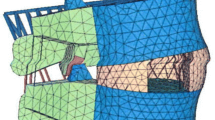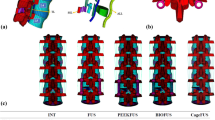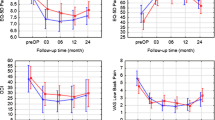Abstract
This biomechanical study was performed to test the primary segmental in vitro stabilising effect of a standard and large footprint radiolucent poly-ether-ether-ketone (PEEK) box cage versus a titanium box cage for anterior lumbar interbody fusion. Eighteen L2-L3 and sixteen L4-L5 cadaveric motion segments were divided into three groups and received a titanium cage or a radiolucent PEEK cage with standard or large footprint. All specimens were tested in three testing conditions: intact, stand-alone anterior cage and finally with supplemental translaminar screw fixation. Full range of motion and neutral zone measurements were determined and anterior cage pull out force was tested. The titanium design was significantly more effective in reducing the range of motion only in axial rotation. The larger footprint radiolucent cage did not increase stability as compared to the standard footprint. The titanium cage pull out force was significantly (P=0.0002) higher compared to both radiolucent cage constructs. Clinical relevance: Supplemental posterior fixation is strongly recommended to increase initial stability of any anterior interbody fusion cage construct. Although the biomechanical stability necessary to achieve spinal fusion is not defined, the radiolucent designs tested in this study, with a standard footprint as well as with a larger footprint, may be insufficiently stabilised with translaminar screws as compared to the titanium implant. Supplemental pedicle screw fixation may be required to obtain adequate stabilisation in the clinical setting.





Similar content being viewed by others
References
Blumenthal SL, Gill K (1993) Can lumbar spine radiographs accurately determine fusion in postoperative patients? Spine 18:1186–1189
Brantigan JW, Steffee AD (1993) A carbon fiber implant to aid interbody lumbar fusion: two-year clinical results in the first 26 patients. Spine 18:2106–2117
Brantigan JW, Steffee AD, Lewis ML, Quinn ML, Persenaire JM (2000) Lumbar interbody fusion using the Brantigan I/F cage for posterior lumbar interbody fusion and the variable pedicle screw placement system. Two-year results from a food and drug administration investigational device exemption clinical trial. Spine 25:1437–1446
Brantigan JW, McAfee PC, Cunningham BW, Wang H, Orbegoso CM (1994) Interbody lumbar fusion using a carbon fiber cage implant versus allograft bone: an investigational study in the Spanish goat. Spine 19:1436–1444
Button G, Gupta M, Barrett C, Barrett C, Cammack P, Benson D (2003) 3 to 6 year follow-up of stand-alone BAK cages. (Poster presentation). Scoliosis Research Society 38th annual meeting Quebec City, Canada
Christensen FB, Hansen ES, Eiskjaer SP, Høy K, Helmig P, Neumann P, Niedermann B, Bünger CE (2002) Circumferential lumbar spinal fusion with Brantigan cage versus posterolateral fusion with titanium Cotrel-Dubousset instrumentation. A prospective, randomized clinical study of 146 patients. Spine 27:2674–2683
Dietl RH, Krammer M, Kettler A, Wilke HJ, Claes L, Lumenta CB (2002) Pull out test with three lumbar interbody fusion cages. Spine 27:1029–1036
Dijk van M, Smit TH, Sugihara S, Burger EH, Wuisman PIJM (2002) The effect of cage stiffness on the rate of lumbar interbody fusion. An in vivo model using poly (L-Lactic Acid) and titanium cages. Spine 27:682–688
Edwards WT, Zheng Y, Ferrara LA, Yuan HA (2001) Structural features and thickness of the vertebral cortex in the thoracolumbar spine. Spine 26:218–225
Fidler MW (1997) Spinal fusion: a combined anterior and supplementary interspinous technique. Eur Spine J 6:214–218
Gilbert TJ, Heithoff KB, Mullin WJ (2001) Radiographic assessment of cage-assisted interbody fusions in the lumbar spine. Seminars in Spine Surgery 13:311–315
Grant JP, Oxland TR, Dvorak MF (2001) Mapping the structural properties of the lumbosacral vertebral endplates. Spine 26:889–896
Kanayama M, Cunningham BW, Haggerty CJ, Abumi K, Kaneda K, McAfee PC (2000) In vitro biomechanical investigation of the stability and stress-shielding effect of lumbar interbody fusion devices. J Neurosurg 93(suppl 2):259–265
Kant AP, Daum WJ, Dean M, Uchida T (1995) Evaluation of lumbar spine fusion: plain radiographs versus direct surgical exploration and observation. Spine 20:2313–2317
Kozak JA, Heilman AE, O‘Brien JP (1994) Anterior lumbar fusion options: technique and graft materials. Clin Orthop 300:45–51
Krammer M, Dietl R, Lumenta CB, Kettler A, Wilke HJ, Buttner A, Claes L (2001) Resistance of the lumbar spine against axial compression forces after implantation of three different posterior lumbar interbody cages. Acta Neurochir (Wien) 143:1217–1222
Kuslich SD, Danielson G, Dowdle JD, Sherman J, Frederickson B, Yuan H, Griffith SL (2000) Four-year follow-up results of lumbar spine arthrodesis using the Bagby and Kuslich lumbar fusion cage. Spine 25:2656–2662
Kuslich SD, Ulstrom CL, Griffith SL, Ahern JW, Dowdle JD (1998) The Bagby and Kuslich method of lumbar interbody fusion. History, techniques and 2-year follow-up results of a United States prospective multicenter trial. Spine 23:1267–1278
Lund T, Oxland TR, Jost B, Cripton P, Grassmann S, Etter C, Nolte LP (1998) Interbody cage stabilisation in the lumbar spine. Biomechanical evaluation of cage design, posterior instrumentation and bone density. J Bone Joint Surg Br 80:351–359
Magerl F (1998) Stabilization techniques: thoracolumbar spine. In: Aebi M, Thalgott JS, Webb JK (eds) AO ASIF principles in spine surgery. Springer, BerlinHeidelberg, New york, pp 101–102
McAfee PC (1999) Interbody fusion cages in reconstructive operations on the spine. J Bone Joint Surg Am 81:859–880
McAfee PC, Boden SD, Brantigan JW, Fraser RD, Kuslich SD, Oxland TR, Panjabi MM, Ray CD, Zdeblick TA (2001) Symposium: a critical discrepancy: a criteria of successful arthrodesis following interbody spinal fusions. Spine 26:320–334
McAfee PC, Cunningham BW, Lee GA, Orbegoso CM, Haggerty CJ, Fedder IL, Griffith SL (1999) Revision strategies for salvaging or improving failed cylindrical cages. Spine 24:2147–2153
Nibu K, Panjabi MM, Oxland T, Cholewicki J (1997) Multidirectional stabilizing potential of BAK interbody spinal fusion system for anterior surgery. J Spinal Disord 10:357–362
Oxland TR, Hoffer Z, Nydegger T, Rathonyi GC, Nolte LP (2000) A comparative biomechanical investigation of anterior lumbar interbody cages: central and bilateral approaches. J Bone Joint Surg Am 82:383–393
Pavlov PW, Meijers H, Limbeek van J, Jacobs WCH, Lemmens JAM, Obradov M, Kleuver de M (2004) Good outcome and restoration of lordosis after anterior lumbar interbody fusion with additional posterior fixation. Spine 29:1893–1900
Polikeit A, Ferguson SJ, Nolte LP, Orr TE (2003) Factors influencing stresses in the lumbar spine after the insertion of intervertebral cages: finite element analysis. Eur Spine J 12:413–420
Polikeit A, Freguson SJ, Nolte LP, Orr TE (2003) The importance of the endplate for interbody cages in the lumbar spine. Eur Spine J 12:556–561
Rathonyi GC, Oxland TR, Gerich U, Grassmann S, Nolte LP (1998) The role of supplemental translaminar screws in anterior lumbar interbody fixation: a biomechanical study. Eur Spine J 7:400–407
Ray CD (1997) Threaded titanium cages for lumbar interbody fusions. Spine 22:667–679
Roberts S, McCall I, Menage J, Haddaway M, Eisenstein S (1997) Does the thickness of the vertebral subchondral bone reflect the composition of the intervertebral disc? Eur Spine J 6:385–389
Santos ER, Goss DG, Morcom RK, Fraser RD (2003) Radiologic assessment of interbody fusion using carbon fiber cages. Spine 28:997–1001
Shah RR, Mohammed S, Saifuddin A, Taylor BA (2003) Comparison of plain radiographs with CT scan to evaluate interbody fusion following the use of titanium interbody cages and transpedicular instrumentation. Eur Spine J 12:378–385
Smit TH, Müller R, Dijk van M, Wuisman PIJM (2003) Changes in bone architecture during spinal fusion: three years follow-up and the role of cage stiffness. Spine 28:1802–1809
Spruit M, Pavlov PW, Leitao J, Kleuver de M, Anderson PG, Boer den F (2002) Posterior reduction and anterior lumbar interbody fusion in symptomatic low-grade isthmic spondylolisthesis: short-term radiological and functional outcome. Eur Spine J 11:428–433
Steffen T, Tsantrizos A, Aebi M (2000) Effect of implant design and endplate preparation on the compressive strength of interbody fusion constructs. Spine 25:1077–1084
Tsantrizos A, Andreou A, Aebi M, Steffen T (2000) Biomechanical stability of five stand-alone anterior lumbar interbody fusion constructs. Eur Spine J 9:14–22
Weiner BK, Fraser RD (1998) Lumbar interbody cages. Spine 23:634–640
Acknowledgements
The study was financially supported by Mathys Medical Ltd, Bettlach, Switzerland. The experiments comply with the current laws of Canada, in which country the experiments were performed.
Author information
Authors and Affiliations
Corresponding author
Rights and permissions
About this article
Cite this article
Spruit, M., Falk, R.G., Beckmann, L. et al. The in vitro stabilising effect of polyetheretherketone cages versus a titanium cage of similar design for anterior lumbar interbody fusion. Eur Spine J 14, 752–758 (2005). https://doi.org/10.1007/s00586-005-0961-z
Received:
Revised:
Accepted:
Published:
Issue Date:
DOI: https://doi.org/10.1007/s00586-005-0961-z




